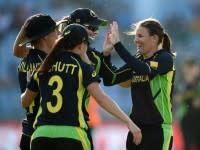Transgender and gender-diverse Australians can now play pro cricket — but they'll need to prove their testosterone levels

Cricket Australia has unveiled new guidelines to support transgender and gender-diverse athletes wishing to play the sport.
Players who identify as female or non-binary and wish to play in professional women's leagues will need to prove their concentration of testosterone has been less than 10 nanomoles per litre (nmol/L) for 12 months before nominating their gender identity — a less strict measure that the protocols in place for the AFL.
Cricketer Megan Schutt said cricket can now claim to be "a sport for all".
Cricket Australia is taking a step forward on inclusion, with new guidelines supporting transgender and gender-diverse people wishing to play the sport both locally and at the elite level.
Today we take a major step to ensure inclusiveness is at the heart of Australian Cricket.
Learn more about the inclusion of transgender and gender diverse people in the game: https://t.co/XbewXwazH4#ASportForAll pic.twitter.com/cRlM2TKx21— Cricket Australia (@CricketAus) August 7, 2019
Cricket Australia said the guidelines for community cricket will help clubs, players, administrators, coaches and other volunteers “deliver a safe, welcoming and inclusive environment, free of harassment and discrimination for gender diverse players at the game’s grassroots”.
“It doesn’t make any sense that today, people are discriminated against, harassed or excluded, because of who they are,” Cricket Australia CEO Kevin Roberts said in a statement. “And that’s not right.”
“As strength, stamina and physique are all relevant factors when competing in competitive sport, transgender and gender diverse players will be supported to participate in elite cricket, subject to certain criteria through the implementation of this policy.
“Our dedication to a fair and inclusive sport across international and domestic competitions sees the policy strike a balance between the opportunity to participate and ensuring fair competition.”
Roberts added that at a community level, there will be support networks for people who face any kind of harassment or discrimination because of their sex or gender identity.
“Discrimination of any sort has no place in the game and all of Australian Cricket is driven to ensure all cricketers can participate in a harassment-free environment,” he added.
Australian cricketer Megan Schutt, who plays for national women's team, said Cricket Australia’s vision is to be “a sport for all”.
“To have a policy and guidelines that includes transgender and gender diverse players will create a better environment for everybody to play the game,” she said in a statement.
“Now that we know that anyone who is transgender or gender diverse has a chance to play cricket at the highest level - and rightfully so - I'm confident that the elite cricket policy will provide a fair process for transgender and gender diverse cricketers to embark on that pathway.”
As part of the community level guidelines, players have to nominate the gender identity they wish to use when registering for the sport. They must also “demonstrate a commitment that their gender identity is consistent with their gender identity in other aspects of everyday life.”
However, clubs and associations are not to ask any player to undergo a medical exam to verify their gender.
When it comes to professional cricket, players have to nominate their gender identity to the Head of Integrity — which will remain confidential.
Those who identify as female or non-binary also have to prove their concentration of testosterone has been less than 10 nanomoles per litre (nmol/L) for 12 months before nominating their gender identity.
This is compared to guidelines for transgender and non-binary athletes wishing to play in the AFL, as they have to maintain a testosterone level at or below 5 nmol/L for at least two years.
David Hughes, chief medical officer at the Australian Institute of Sport, told the ABC that 98% of women have under two nanomoles of testosterone.
"For men, the amount averages between 7.7 and 29 nanomoles, in sports that involve power and endurance testosterone gives players an 8-12 per cent advantage," he said.
Alex Blackwell, Australian cricketer and LGBTI advocate said in a Cricket Australia-produced YouTube video that it has taken six months to get the new policy down. "We thought it was really, really important that trans and gender diverse people participate in the creation of that policy so I'm very proud to say that that has happened.” And one of the people who has been part of the development of the new policy is transgender cricketer athlete Erica James who plays in the Universities Women's Cricket Club.
View this content at Business Insider
The new policy comes as the issue of testosterone levels in sport is being tacked by sporting bodies around the globe, particularly highlighted in the case of South African Olympian Caster Semenya.
In 2018, the International Association of Athletics Federations (IAAF) introduced new regulations requiring runners with differences of sex development - at levels of circulating testosterone five nmol/L or above - to lower their naturally high levels of testosterone if they wish to compete.
In June 2018, Semenya requested that the Court of Arbitration for Sport (CAS) declare the DSD Regulations invalid, however, it was rejected.
Semenya then appealed to the Switzerland Federal Supreme Court, which temporarily suspended the rule requiring all DSD athletes - which included Caster Semenya - to reduce their testosterone levels.
However, the Swiss Court later overturned its ruling in July 2019.
“The IAAF will maintain its position that there are some contexts, sport being one of them, where biology has to trump gender identity,” the IAAF said in a statement.
So while some sports have taken a step forward, it seems others still have a way to go.

 Yahoo Finance
Yahoo Finance 
